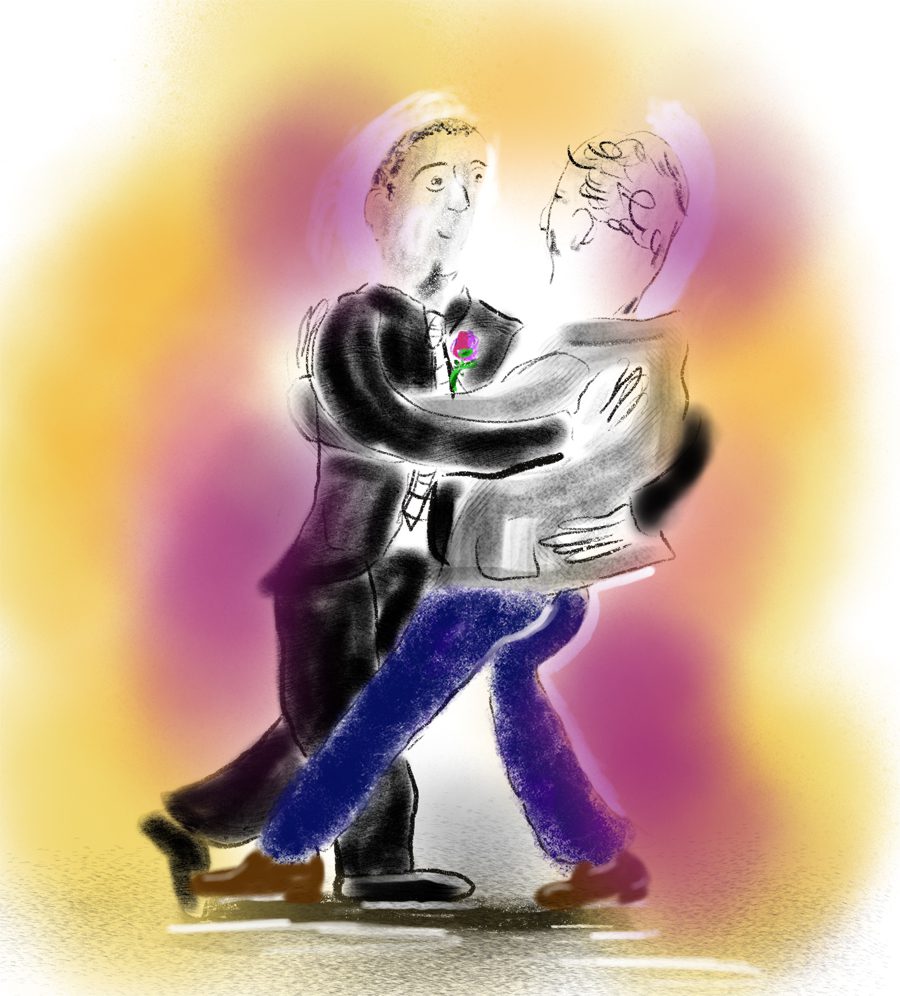The Space Age drifted all around me: Major Matt Mason toys in various heroic poses on the basement floor, plastic red-and-blue rockets ascending and landing, the interstellar playing out under the pool table as astral 45s by Eumir Deodato (“Also Spake Zarathustra 2001”) and Vik Venus (“Moonflight”) revolve on the Bonomo family stereo.
The latter was one of those novelty “cut-in” songs popular in the 1960s, a faux Q&A with astronauts using Top 40 song snippets as answers. New York’s WMCA dj Jack Spencer asked the questions. Samples:
Q: Commander Rah Rah, we’d like to ask you a few questions now.
A: Goody goody gum drops, my heart is doing flip-flops! [warbled by 1910 Fruitgum Company]
Q: If you’re confronted by any creatures as you explore the moon surface, what would you tell them?
A: Welcome me love, I know you don’t know me, take my hand, there’s a lot you can show me! [Brooklyn Bridge]
Etc.. It kept us in stitches. Also in high rotation in the Bonomo rec room during these years was Journey To The Moon, released in July of 1969 by Buddah Records in an attempt to celebrate and honor — and cash in on — the Apollo 11 moon-landing mission. Boasting on its cover “Recorded live on Earth, in Space, on the Moon,” the album twined NASA command-control audio with bold narration and spacey acid-rock and psychedelic instrumentals. The music was recorded in Philadelphia with Sound of Genesis, a session group featuring then-unknown keyboardist Daryl Hall under the command of producer John Madara (best known for having co-written “At The Hop” in 1957). Future singer-songwriter Tim Moore, also in the band, co-wrote the bulk of the album with Madara, whose industry friend Len Barry of the Dovells fame (“You Can’t Sit Down,” “The Bristol Stomp”) co-wrote the title track. Under the auspices of Buddah Records’ visionary president Neil Bogart, Madara and producer partner Tom Sellers created an album wholly of its prophetic, New Dawn era. Madara stated in an interview, “Neil Bogart wanted to be the first record company out with authentic conversations with the astronauts and others, including President Nixon, using original music that we composed,” adding that Journey To The Moon “was approved by NASA, who sent in the tapes every day to us of the moon flight, which we used on the LP.” The resulting album is trippy, corny, earnest, unintentionally funny, and wonderfully evocative.
How Journey To The Moon splashed down in our house in suburban Washington D.C., I’m not so certain. My dad probably picked up the album at Korvette’s or Dart Drug. For decades he was employed as an engineer at IBM where, among other responsibilities, he worked with NASA on their unmanned scientific spacecraft program, as well as with navigation, meteorology, astronomical and earth-survey satellites, ballistic missile defense, telecommunication and highly classified military intelligence systems, launch vehicle payload weight analysis and allocation, geosynchronous orbit and system reliability analysis, and Global Positioning Satellites. The back of the computer paper that he brought home from work for me to draw on spoke a language of 1’s and 0’s that I never comprehended, but its futuristic cadence struck me; I grew up with lunar images decorating the house and plaques of commemoration and gratitude from NASA on the walls. I Dream Of Jeannie on TV and Tang in the kitchen were for me both cultural and personal. Listening to Journey To The Moon in the rec room I’d unconsciously sift the hype and the myth of the Moon Landing Era from the reality of my dad’s job — of which, I must admit, I knew very little as a kid. (“He’s an engineer,” I’d tell kids on the playground, unsure if that meant that he rode around on a train all day.) But as I grew, I intuited that my dad had something to with the moon landings. Journey To The Moon provided the score.
Beyond the autobiographical, the album matters as a pop touchstone for a lost era, a vinyl time capsule made. The cover drawing of a full moon against a boundless-black background with sunlight dappling the surface in neon yellow-green — surely no color found in the natural world — announced the gravitas inside: this is an otherworldly record. Look: Music by Sound of Genesis. The song titles, set in a curve hugging the moon’s lower half: “The Mystery Of Space,” “Sea Of Tranquility,” “Empty, Void,” “Nineteen Ninety Nine,” and…“Space Rock?” Well, it was the late Sixties. Amps were bigger, hair was longer, festivals were sprouting, moods were altering, the universe was Infinite. Why not rock out and celebrate Space?
Nothing less than a heroic Monday Night Football-type theme for space geeks, “Journey To The Moon” kicks off the album with a lonely horn offering two notes an octave apart while an announcer, his voice tinny and far-away, gravely intones the opening passage from the Book of Genesis. Heady stuff. A honky-tonk piano tumbles in, the band catches up, and the interstellar groove is on. Imagine if in 1972 Edgar Winter snorted a few lines and impulsively recorded a faster version of his stomping “Frankenstein;” then imagine a blend of the Telstars, Davie Allan and the Arrows, and some nameless suburban garage band hopefully lumbering through a prog-rock instrumental (while hoping no one’s listening), and you’ll get an idea of the vibe in the title track.
The song ascends via calls-and-responses between racks of keyboards and fat horns, lashed on by tambourines and bongos, leading to the bridge’s wandering bars of cosmological organ meant to evoke the infinite winding miles into dark space aboard the cruising Apollo spacecraft. Things slow down in the final third as the band recedes while a boing boing synthesizer effect gives way to the return of the disembodied Voice who reminds us, as if we haven’t been dabbing our eyes as we’ve been dancing, that man “now has the audacity to reach for the stars, and get there.” Corny, yes, but this monumental echo of John F. Kennedy’s Space Race mandate sends the song soaring to its anthemic finish and anoints the project with the kind of late Sixties American pride and exceptionalism that really must’ve sounded, and felt, like the theme for the epoch. So commercially promising was its exhilarating blend of celebratory groove and boundless optimism that “Journey To The Moon” was released as a single by Buddah. But the wake imposed by, among others, Fifth Dimension’s monster hit “Aquarius/Let The Sunshine In,” trippily similar in vibe and ethos, kept the 45 off of the Billboard charts.
In the album’s liner notes, Richard Robinson writes, “Despite the highly scientific reality of the Apollo project, fantasy is still an inherent part of the journey. We don’t know exactly why we’re going, the moon is there so we have to go. And we certainly don’t know where this display of a million years of discovery and sophistication will lead mankind.” Madara, Sellers, and Moore were charged with scoring these august sentiments, and the fantastical moon landing, the experimental climate in the country, and the rise of FM progressive rock demanded this curious, now-dated artifact of evocative generic rock. The phrase “evocative generic rock” seems paradoxical, but Journey To The Moon evokes the NASA Zeitgeist at the dawn of the 1970s, an idealistic marriage of crew-cut ingenuity and long-haired psychedelia, outer and inner space co-mingling.
As a kid rocking out in the rec room, I didn’t register any of this, of course, I just dug the album’s playfulness. Buddah took out a full-page advertisement for Journey To The Moon in Billboard on August 2, 1969, crowing, “THE 30 BILLION DOLLAR ALBUM,” surely a reference to the Apollo mission price tag, not the album’s recording budget. The production values strike these twenty-first century ears as old-fashioned, and that’s part of the fun. Throughout, Victor Jay’s narration is buttoned-up, Cronkite Serious, lending an air of legitimacy to the enterprise. Sound Of Genesis creates the “modern” ambience behind the NASA and the astronaut chatter: the analog music bouncing off of the glimmering Pacific, cheerful and triumphant.
If naïve in retrospect, it’s also movingly redolent of the era. In Dark Side Of The Moon: The Magnificent Madness Of The American Lunar Quest, Gerald Degroot essays the moon landing with a long view, wondering if the event lacked lasting significance. “People accepted that that one small step was a giant leap for mankind simply because Armstrong said it was so,” Degroot argues. “Few paused to consider how walking around the moon in a space suit brought progress to mankind.” He asks how the mission helped the starving in Africa, or the plight of Vietnamese peasants mired between communism and capitalism. He adds, “Did African-Americans watching the landing in a fetid shack in Alabama suddenly shout: ‘Golly, my life is so much better because Neil took that small step!’ Some people obviously thought so.” Journey To The Moon steers clear of such arguments, dazzled by achievement, celebrating it in song, assuming the cultural importance of a sun-splashed spectacle. Certainly Buddah Records had consumerism in mind; the same year that the label released this album they released one celebrating the New York Mets’ improbable season. Both albums had a stake in their own commercial success; both originated, in part, in exploitation. But decades down the line, Journey To The Moon feels less exploitative than simply, innocently, awe-struck.
If integral calculus has a nerd-heroic theme song, it’s “The Computer,” Madara’s Variety Show song-painting conjuring festive images of NASA’s computer feats against an infinite dark and the receding earth. The imaginatively titled “Space Rock” caps off the first side with forced cheer, generic go-go music trying a bit too hard to project rockin’ astronauts; I can’t picture Neil or Collins or Buzz frugin’ on the surface of the moon, as much as I want to. “A Walk On The Moon” is more appropriate musically — despite the touch of what sounds like a banjo filtered through a lunar module flight board — a loping, easy stroll of a song with bright, optimistic chord changes. Prefaced by a brief, mysterious sitar/keyboard/guitar piece (the conclusion of “Empty Void”), “Nineteen Ninety Nine” doesn’t offer the abstract futuristic tones of the unknown you might expect from the title; instead, a chirpy flute-and-horn melody sits atop an arrangement that skips along, suggesting an upbeat tomorrow. Three decades away at the album’s release, the year 1999 must’ve felt close in spirit, however idealized the cultural projection turned out to be.
Winding among the instrumentals and balancing out the album are Jay’s straightforward narration of the Apollo flight chronology, and segments, ranging from four to eight minutes, of audio verite: NASA speaking with the astronauts from their liftoff to their minutes on the moon’s surface to their reentry in the atmosphere; President Nixon’s famous phone call to the astronauts is included, as is, of course, Armstrong’s immortal words upon stepping onto the moon. The album concludes atmospherically, with several seconds of studio-created lunar wind as Jay sums up the significance of the events between July 16 and 24th. At just under 34 minutes, Journey To The Moon manages to document, teach, and groove at the same time. If not an engineering feat rivaling NASA’s, it’s a pretty impressive bundling together of disparate parts.
Two years after the release of Journey To The Moon an article appeared in Billboard announcing that Buddah Records was expanding into education programs. Select Buddah artists were to supply “background music for scientific, social studies, art, literature and geography lessons put together by Planetariums Unlimited for classroom instruction.” None other than Journey To The Moon’s Victor Jay was employed, in conjunction with classroom celebrations of the recent moon landings. Alas, I don’t recall Sister Irene in the All Purpose Room at St. Andrew The Apostle School dropping the needle on Journey To The Moon. Perhaps with this educational “tie-in” initiative Buddah was trying to distance itself from its Bubblegum Pop heritage; I don’t know how successful or not was the move. Journey To The Moon did not fare terribly well commercially, and remains out of print. That’s criminal. Its eBay and GEMM prices fluctuate, and online you can find plenty of bemused commentary about the album and the odd downloadable song. Until Journey To The Moon is re-released, those of us lucky enough to have grown up with the album in the 1970s will content ourselves with memories of a curio, in its way both a crass and a loving accolade to the Space Race, Psychedelic Rock, and our once star-bright future.




